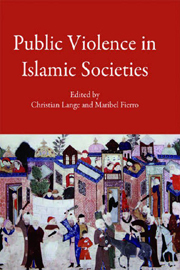 Public Violence in Islamic Societies
Public Violence in Islamic Societies Book contents
- Frontmatter
- Contents
- List of abbreviations
- Acknowledgements
- Introduction: Spatial, ritual and representational aspects of public violence in Islamic societies (7th–19th centuries ce)
- PART I Public violence and the construction of the public sphere
- PART II Ritual dimensions of violence
- PART III Representations of public violence
- 9 Responses to crucifixion in the Islamic world (1st–7th/7th–13th centuries)
- 10 Violence and the prince: the case of the Aghlabid Amīr Ibrāhīm II (261–89/875–902)
- 11 Concepts of justice and the catalogue of punishments under the Sultans of Delhi (7th–8th/13th–14th centuries)
- 12 Public violence, state legitimacy: the Iqāmat al-ḥudūd and the sacred state
- 13 Violence in Islamic societies through the eyes of non-Muslim travellers: Morocco in the 19th and early 20th centuries
- Index
11 - Concepts of justice and the catalogue of punishments under the Sultans of Delhi (7th–8th/13th–14th centuries)
from PART III - Representations of public violence
Published online by Cambridge University Press: 12 September 2012
- Frontmatter
- Contents
- List of abbreviations
- Acknowledgements
- Introduction: Spatial, ritual and representational aspects of public violence in Islamic societies (7th–19th centuries ce)
- PART I Public violence and the construction of the public sphere
- PART II Ritual dimensions of violence
- PART III Representations of public violence
- 9 Responses to crucifixion in the Islamic world (1st–7th/7th–13th centuries)
- 10 Violence and the prince: the case of the Aghlabid Amīr Ibrāhīm II (261–89/875–902)
- 11 Concepts of justice and the catalogue of punishments under the Sultans of Delhi (7th–8th/13th–14th centuries)
- 12 Public violence, state legitimacy: the Iqāmat al-ḥudūd and the sacred state
- 13 Violence in Islamic societies through the eyes of non-Muslim travellers: Morocco in the 19th and early 20th centuries
- Index
Summary
Kings should know that the meaning of siyāsa is making right the affairs of the world.
– Ḍiyāɔ al-Dīn BaraīHistorians of the Delhi Sultanate, during the 7th/13th and 8th/14th centuries, interwove themes of justice (cadl) and punishment (siyāsa) to legitimate Muslim political authority. Justice was portrayed as a key component of kingship and the foundation on which conceptions of Muslim rule were built. Punishment was equally central to representations of Muslim authority established in the Indian subcontinent under the imperial rubric of the sultans of Delhi. In the historiography of the period, justice and punishment were depicted as flowing from two distinct and ideally complementary structures of political power. One structure drew its legitimacy from ideas of pre-Islamic Persian kingship formalized in a set of rules, known as ḍavābiṭ. These rules afforded the sultan a wide range of discretion in executing the prerogatives of his high office. A second structure was built upon Islamic constructions of authority defined by sharīca, and codified in a restricted body of legal principles monitored by the culamāɔ, who were viewed as its ultimate arbitrators. These dichotomous sources of political legitimacy that perpetuated distinct legal categories blurred the dividing line between perfect justice and excessive punishment.
To address this issue, historians of the Delhi Sultanate devoted particular attention to questions of political legitimacy on the occasions of punishment, particularly in the fashion of the most absolute form of punishment, the death penalty.
- Type
- Chapter
- Information
- Public Violence in Islamic SocietiesPower, Discipline, and the Construction of the Public Sphere, 7th-19th Centuries CE, pp. 238 - 255Publisher: Edinburgh University PressPrint publication year: 2009


